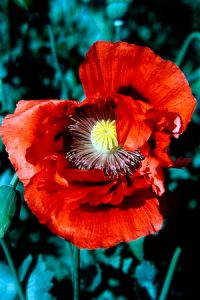The opium poppy, effortlessly sprouting across several continents, has captured the attention of humankind for thousands of years. Likely due to its sedative effects, the ubiquitous scarlet flower has consistently been associated with death. The Greeks depicted Hypnos and Thanatos, the gods of sleep and death, donning crowns of red poppies. After World War I, millions of people began to line their pockets with the same red petals in remembrance of the fallen soldiers. Today in the US, the flower reminds us an alarming epidemic, claiming thousands of lives each year: the opioid crisis. But before that, another opiate crisis loomed large in a different empire: the Qing dynasty.
Throughout the 18th century, Britain facilitated unbalanced trade with China that heavily consisted of opium exports to China; by 1767, Britain was exporting two thousand chests of opium to the country each year. In 1839, Lin Zexu, the Chinese imperial commissioner, put a foot down on its trade and enacted laws banning the substance from the country. In a letter to Queen Victoria, Lin Zexu questioned why Britain continued to supply opium to China, considering that it was banned in Britain:
I have heard that you strictly prohibit opium in your own country, indicating unmistakably that you know how harmful opium is. You do not wish opium to harm your own country, but you choose to bring that harm to other countries such as China. Why?
There was no response to the letter. What followed was two opium wars, eventually forcing China to legalize the importation of opium. The effects ultimately derailed the country and toppled the Qing Dynasty.
Fast forward to 2018: America is facing a public health emergency, wrangling with the devastating consequences of opioid addiction. Back in November, President Donald Trump announced that he would discuss with Chinese President Xi Jinping on how to stop the “flood of cheap and deadly” fentanyl “manufactured in China” into the United States. (Fentanyl is a particularly deadly type of opioid, 50 to 100 times stronger than morphine; large quantities of the substance are reportedly being illegally shipped to the US.)
The very mechanism that makes opioid highs so euphoric is also what makes them so deadly: once opioids enter the bloodstream, they bind to receptors in the brain, producing effects that block pain and provide relief, but also slow breathing. Victims of overdose often die from respiratory depression, physically unable to breathe in enough oxygen to keep their organs alive. Perhaps this is why humankind cannot seem to shake its toxic obsession with the opium poppy, century after century being lulled into the sweet calm it provides, only be led into a tortured death by addiction. One thing is for certain: the United States must take urgent action to address the epidemic, lest we see the fall of another empire.
Sources:
“Lin Zexu: Letter to Queen Victoria, 1839.” Longman World History, wps.pearsoncustom.com/wps/media/objects/2427/2486120/chap_assets/documents/doc24_1.html.
Maron, Dina Fine. “How Opioids Kill.” Scientific American, 8 Jan. 2018, www.scientificamerican.com/article/how-opioids-kill/.
“Opium Throughout History.” PBS, Public Broadcasting Service, www.pbs.org/wgbh/pages/frontline/shows/heroin/etc/history.html.
Pletcher, Kenneth. “Opium Wars.” Encyclopædia Britannica, Encyclopædia Britannica, inc., 9 Mar. 2017, www.britannica.com/topic/Opium-Wars.
Wee, Sui-lee, and Javier C. Hernandez. “Despite Trumps Pleas, Chinas Online Opioid Bazaar Is Booming.” The New York Times, The New York Times, 8 Nov. 2017, www.nytimes.com/2017/11/08/world/asia/china-opioid-trump.html.


One response to “A History of Poppies, War, and Death”